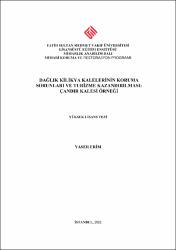| dc.contributor.advisor | Kudumovic, Lana | |
| dc.contributor.author | Erim, Yaser | |
| dc.date.accessioned | 2022-01-13T07:43:25Z | |
| dc.date.available | 2022-01-13T07:43:25Z | |
| dc.date.issued | 2021 | en_US |
| dc.identifier.citation | ERİM, Yaser, Dağlık Kilikya Kalelerinin Koruma Sorunları ve Turizme Kazandırılması: Çandır Kalesi Örneği, Fatih Sultan Mehmet Vakıf Üniversitesi Lisansüstü Eğitim Enstitüsü Mimarlık Anabilim Dalı Mimari Koruma ve Restorasyon Programı, Yayımlanmamış Yüksek Lisans Tezi, İstanbul 2021. | en_US |
| dc.identifier.uri | https://hdl.handle.net/11352/4028 | |
| dc.description.abstract | Mersin’in tarihi en eski olarak Yumuktepe Höyüğü’nde günümüze kadar yapılan kazılara göre M.Ö. 6300’lere dayanmaktadır. Kuzeyde Toros Dağları tarafından korunan, güneyinde Akdeniz bulunan, doğuyu batıya bağlayan önemli bir jeopolitik konumda bulunan kent tarih boyunca dönemin güçlü medeniyetleri tarafından ele geçirilmiştir. Osmanlı topraklarına ise nihayet 1607 yılında katılmıştır.
Kilikya’da Roma ve Bizans İmparatorluğunun hüküm sürdüğü dönemlerde bir çok imar faaliyeti yapılmıştır. Mersin ve ilçelerinde olmak üzere kale, gözetleme kulesi, liman kenti, ören yeri, su kemeri, kilise, manastır, hamam, mezarlık, köprü, sarnıç, kuyu, lahit, mozaik, yol vb. mimari eserler bulunmaktadır. Genellikle şehir merkezinin dışında sahil ve dağlık alanlara dağılmış olan bu eserler çoğunlukla el değmemiş vaziyettedir ve yok olma riski taşımaktadır.Bu tez kapsamında Dağlık Kilikya’da belirlenen beş adet kültürel mirasın tarihi, coğrafi ve mimari özellikleri incelenip, belgelenmek suretiyle koruma sorunları irdelenmiştir. Bu eserlerin kültürel mirası koruma ilkeleri doğrultusunda sürdürülebilir turizme kazandırmak yoluyla gelecek kuşaklara aktarılması ve bölgede yapılabilecek benzer faaliyetlere katkı sunululması amaçlanmıştır. Yapıların mevcut durumları gözetlenerek her birinin kendi başına korunması adına, daha sonra bu yapıları sürdürülebilir bir şekilde korumak için birlikte değerlendirerek bir turizm kültür yolu oluşturma amacı doğrultusunda öneriler sunulmuştur.
Çandır Kalesi örneği ise detaylı bir şekilde ele alınarak rölöve çizimi yapılarak belgelenmiş, koruma ve işlevlendirme önerileri sunulmuştur. Koruma sorunlarının başlıca sebebi yapıların ulaşılması zor coğrafik konumlarda yoğun bitki örtüsü kontrolü altında bulunmasıdır. | en_US |
| dc.description.abstract | According to the excavations carried out in Yumuktepe Tumulus, the oldest history of Mersin, dates back to the 6300's BC. Protected by the Taurus Mountains in the north, the Mediterranean in the south, its is an important geopolitical location connecting the east to the west. The city has been captured by the powerful civilizations throughout history and finally, in 1607, became part of the Ottoman Empire.During the reign of the Roman and Byzantine Empires, many construction activities were carried out in this region including construction of castles, watchtowers, port cities, aqueducts, churches, monasteries, baths, cemeteries, bridges, cisterns, wells, sarcophaguses, mosaics, roads, etc. Currently, the artifacts, which are generally scattered in coastal and mountainous areas outside the city centers are at risk of permanent loss.Within the scope of this thesis, the historical, geographical and architectural features of the five selected cultural heritage assets of fortresses, determined in Highland Cilicia were examined and documented. Also, the conservation problems were examined. This research aims to present potential to preserve them for the future generations in line with the principles of cultural heritage protection and sustainability and to bridge them through tourism. This would be done by proposing tourism cultural route, and it would serve as a good example for other similar activities that can be done in the region. To reach set aims suggestions were prepared to protect each one separately as well as together through active use as a part of cultural route. All together will be good base to reach sustainable cultural assets.In addition, the example of Çandır fortress was discussed in detail and documented by making a survey drawings. Currently, the location is covered by densevegetation which is difficult to reach due to its geographical locations. In final suggestions for protection and active use were presented. | en_US |
| dc.language.iso | tur | en_US |
| dc.publisher | Fatih Sultan Mehmet Vakıf Üniversitesi, Lisansüstü Eğitim Enstitüsü | en_US |
| dc.rights | info:eu-repo/semantics/openAccess | en_US |
| dc.subject | Dağlık Kilikya | en_US |
| dc.subject | Turizm | en_US |
| dc.subject | Kültürel Rota | en_US |
| dc.subject | Aktif Koruma | en_US |
| dc.subject | Kaleler | en_US |
| dc.subject | Çandır | en_US |
| dc.subject | Highland Cilicia | en_US |
| dc.subject | Tourism | en_US |
| dc.subject | Cultural Route | en_US |
| dc.subject | Active Preservation | en_US |
| dc.subject | Fortresses | en_US |
| dc.title | Dağlık Kilikya Kalelerinin Koruma Sorunları ve Turizme Kazandırılması: Çandır Kalesi Örneği | en_US |
| dc.title.alternative | Conservation Problems of Highland Cilicia Castles and Bringing Them to Tourism: The Case of Çandır Castle | en_US |
| dc.type | masterThesis | en_US |
| dc.contributor.department | FSM Vakıf Üniversitesi, Lisansüstü Eğitim Enstitüsü, Mimarlık Ana Bilim Dalı Ana Bilim Dalı | en_US |
| dc.relation.publicationcategory | Tez | en_US |
| dc.contributor.institutionauthor | Erim, Yaser | |



















